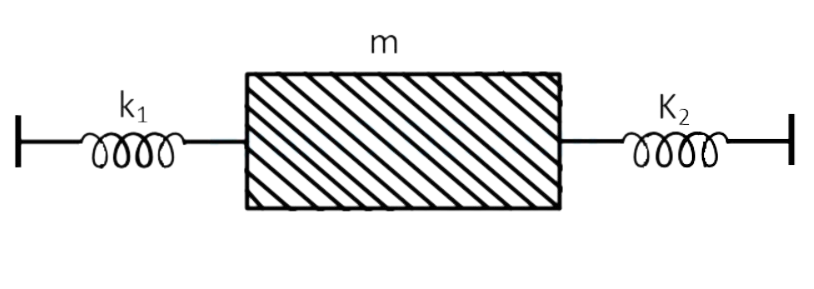Correct Answer is Option (B)
m(l0 + x) = kx
x =
For k >> m
21.(JEE Main 2020 (Online) 9th January Evening Slot)
A spring mass system (mass m, spring constant k and natural length ) rest in equilibrium on a horizontal disc. The free end of the spring is fixed at the centre of the disc. If the disc together with spring mass system, rotates about it's axis with an angular velocity , (k ) the relative change in the length of the spring is best given by the option :
A.
B.
C.
D.
22.(JEE Main 2017 (Online) 8th April Morning Slot)
A 1 kg block attached to a spring vibrates with a frequency of 1 Hz on a frictionless horizontal table. Two springs identical to the original spring are attached in parallel to an 8 kg block placed on the same table. So, the frequency of vibration of the 8 kg block is :
A.
B.
C.
D. 2 Hz
23.(AIEEE 2007)
Two springs, of force constant and are connected to a mass as shown. The frequency of oscillation of the mass
is If both and are made four times their original values, the
frequency of oscillation becomes

A. 2f
B. f/2
C. f/4
D. 4f
24.(AIEEE 2004)
A particle at the end of a spring executes with a period . While the corresponding period for another spring is . If the period of oscillation with the two springs in series is then
A.
C.
D.
25.(AIEEE 2003)
A mass is suspended from a spring of negligible mass. The spring is pulled a little and then released so that the mass executes of time period If the mass is increased by the time period becomes . Then the ratio of is :
A.
B.
C.
D.
Correct Answer is Option (C)
The time period of a simple harmonic motion (SHM) performed by a mass-spring system is given by the formula:
where:
We know that if the mass is increased by m, the time period becomes . We can set up an equation for this new scenario:
Since we know that , we can substitute T in the equation above:
Squaring both sides of the equation to eliminate the square root, we get:
Solving for , we get: